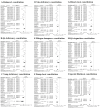Bridging tradition and innovation: a constitution-guided framework for personalized blood pressure management in acute ischemic stroke
- PMID: 40672816
- PMCID: PMC12263929
- DOI: 10.3389/fmed.2025.1602274
Bridging tradition and innovation: a constitution-guided framework for personalized blood pressure management in acute ischemic stroke
Abstract
Background: Elevated blood pressure (BP) in acute ischemic stroke (AIS) significantly impacts clinical outcomes, yet optimal BP management remains contentious due to patient heterogeneity. Traditional Chinese medicine (TCM) constitution theory categorizes individuals into distinct physiological patterns, offering a novel framework to address this variability. This study integrates TCM constitutional theory into modern AIS care to propose a personalized BP management hypothesis.
Methods: A systematic review and meta-analysis were conducted across nine databases, including PubMed, Web of Science, Scopus, the Cochrane Library, ScienceDirect, the Chinese National Knowledge Infrastructure, Wanfang Data, VIP Database, and China Biology Medicine, covering publications up to January 2025. We analyzed TCM constitution distributions in AIS, hypertension, hypotension, AIS with hypertension, ischemic stroke (IS) with hypertension, and ischemic cerebrovascular disease with hypoperfusion, correlating constitutional types with clinical outcomes. We employed the Agency for Healthcare Research and Quality (AHRQ) checklist to evaluate the methodological quality of cross-sectional studies and utilized the Newcastle-Ottawa Scale (NOS) for quality assessment of cohort and case-control studies. Subgroup and sensitivity analyses were performed, and publication bias was assessed. A constitution-guided framework for BP management was developed through evidence synthesis.
Results: Fifty-four studies were included in the study, with the majority being of moderate-to-high quality. The findings demonstrated that Phlegm-dampness, Qi-deficiency, Yin-deficiency, and Blood-stasis constitutions predominated in AIS patients with hypertension. Subgroup and sensitivity analyses confirmed the robustness of the results. Most analyses demonstrated no evidence of publication bias. Although several analyses indicated potential publication bias, the primary conclusions withstood the trim-and-fill adjustment and remained robust. A TCM constitution-based BP management hypothesis was proposed: patients with Phlegm-dampness or Blood-stasis constitutions may benefit from intensive BP control, whereas Qi-deficiency and Yin-deficiency types may require conservative strategies to mitigate hypoperfusion risks.
Conclusion: This integration of TCM constitutional theory into AIS BP management provides a potential framework for advancing precision care to improve clinical outcomes in AIS patients. Further validation in multicenter cohorts and mechanistic exploration is warranted to enhance clinical applicability (Registration information: https://www.crd.york.ac.uk/PROSPERO2/view/CRD420250655689).
Keywords: TCM constitution; acute ischemic stroke; blood pressure management; hypothesis and theory; personalized medicine.
Copyright © 2025 Zhang, Cao, Zhou, Liu and Ding.
Conflict of interest statement
The authors declare that the research was conducted in the absence of any commercial or financial relationships that could be construed as a potential conflict of interest.
Figures









Similar articles
-
Systemic pharmacological treatments for chronic plaque psoriasis: a network meta-analysis.Cochrane Database Syst Rev. 2021 Apr 19;4(4):CD011535. doi: 10.1002/14651858.CD011535.pub4. Cochrane Database Syst Rev. 2021. Update in: Cochrane Database Syst Rev. 2022 May 23;5:CD011535. doi: 10.1002/14651858.CD011535.pub5. PMID: 33871055 Free PMC article. Updated.
-
Participation in environmental enhancement and conservation activities for health and well-being in adults: a review of quantitative and qualitative evidence.Cochrane Database Syst Rev. 2016 May 21;2016(5):CD010351. doi: 10.1002/14651858.CD010351.pub2. Cochrane Database Syst Rev. 2016. PMID: 27207731 Free PMC article.
-
Regional cerebral blood flow single photon emission computed tomography for detection of Frontotemporal dementia in people with suspected dementia.Cochrane Database Syst Rev. 2015 Jun 23;2015(6):CD010896. doi: 10.1002/14651858.CD010896.pub2. Cochrane Database Syst Rev. 2015. PMID: 26102272 Free PMC article.
-
Non-invasive ventilation for the management of acute hypercapnic respiratory failure due to exacerbation of chronic obstructive pulmonary disease.Cochrane Database Syst Rev. 2017 Jul 13;7(7):CD004104. doi: 10.1002/14651858.CD004104.pub4. Cochrane Database Syst Rev. 2017. PMID: 28702957 Free PMC article.
-
Systemic pharmacological treatments for chronic plaque psoriasis: a network meta-analysis.Cochrane Database Syst Rev. 2017 Dec 22;12(12):CD011535. doi: 10.1002/14651858.CD011535.pub2. Cochrane Database Syst Rev. 2017. Update in: Cochrane Database Syst Rev. 2020 Jan 9;1:CD011535. doi: 10.1002/14651858.CD011535.pub3. PMID: 29271481 Free PMC article. Updated.
References
LinkOut - more resources
Full Text Sources

